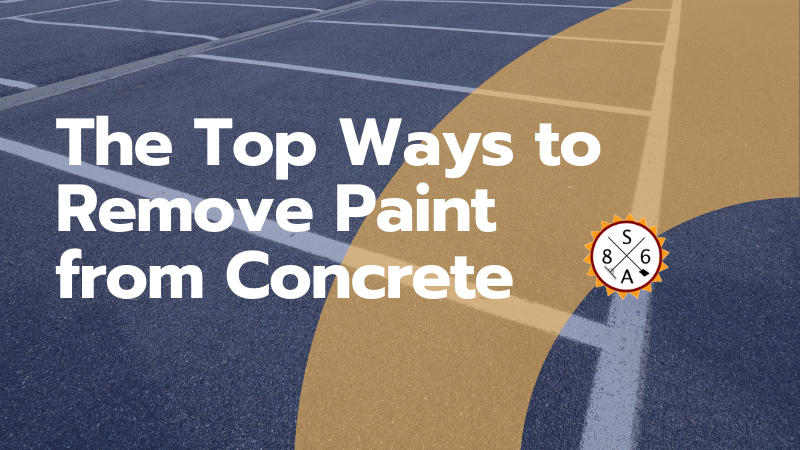
The Top Ways to Remove Paint from Concrete
Do you need to remove paint on concrete, but you aren’t sure where to start? There are a number of methods for stripping it. These create a clean surface ready for repainting or concrete repair. Some important factors include:
- How much surface area you’re dealing with
- What condition the paint is in
- Your technical skill level
Here are five methods for removing unwanted paint from commercial concrete:
Elbow Grease
If you have a small spill of wet or badly weathered paint, you may be able to simply scrub it off. You’ll need a scraper, a wire brush, some upper body strength, and plenty of patience.
Sweep the area and apply a cleaning solution. Diluted trisodium phosphate works well here. If you don’t have that or aren’t comfortable working with it, try soap and water. Wet the area down and let it sit for a few minutes before beginning to work. Re-wet the concrete as you go. If nothing else, you may be able to remove enough paint that you’ll only need one round of paint stripper to take off the rest.
Power Washer
If you have a commercial power washer, there is a chance that it can handle this problem. Power washers can be very effective for still-wet paint from spills. It may also be used to remove old, cracked, or peeling paint. However, dry and cured paint in good condition may require more aggressive methods of removal.
Paint Stripper
Paint strippers are very effective and can clear off large areas of paint. However, these chemicals can be dangerous, so follow the instructions carefully.
Start the process with a thorough concrete cleaning. Use a broom or vacuum. If necessary, scrub off sticky residue with soap and water.
Next, get a chemical paint stripper from your local building supply or home improvement company. If you know whether the paint is oil based or water based, use a paint stripper formulated for that. Otherwise, try products intended for oil based paint.
Apply the paint stripper. Make sure that you wear protective gear. Once the stripper has set for enough time (this varies by the brand), scrape up softened paint and scrub the area with a wire brush. If some paint remains, repeat the process.
Scouring Paste
To make a scouring paste, simply mix a chemical paint stripper with something absorbent. Many people use crushed cat litter or powdered clay. Next, apply the paste and wait. Fast acting paint strippers may require 20 minutes to soak in, while slower formulations may need several hours.
Scrape the excess paste off and then scrub the area. The combination of an abrasive with the chemicals should help lift the paint in one or two applications.
Soda Blasting
This is a ‘dry’ form of scouring that blasts the area with chemical powders. Like with paint strippers, this is effective for larger areas. Baking soda is the most commonly used chemical. You’ll need to rent a pot blaster and purchase some coarser soda. Sand blasters cannot handle this job, and household baking soda is too fine to be effective. You should be able to buy the right kind of soda from the same place where you got the pot blaster. Follow the directions carefully, and don’t forget to use a respirator or dust mask while working.
Do you need to remove paint on concrete, but you aren’t sure where to start? There are a number of methods for stripping it. These create a clean surface ready for repainting or concrete repair. Some important factors include:
- How much surface area you’re dealing with
- What condition the paint is in
- Your technical skill level
Here are five methods for removing unwanted paint from commercial concrete:
Elbow Grease
If you have a small spill of wet or badly weathered paint, you may be able to simply scrub it off. You’ll need a scraper, a wire brush, some upper body strength, and plenty of patience.
Sweep the area and apply a cleaning solution. Diluted trisodium phosphate works well here. If you don’t have that or aren’t comfortable working with it, try soap and water. Wet the area down and let it sit for a few minutes before beginning to work. Re-wet the concrete as you go. If nothing else, you may be able to remove enough paint that you’ll only need one round of paint stripper to take off the rest.
Power Washer
If you have a commercial power washer, there is a chance that it can handle this problem. Power washers can be very effective for still-wet paint from spills. It may also be used to remove old, cracked, or peeling paint. However, dry and cured paint in good condition may require more aggressive methods of removal.
Paint Stripper
Paint strippers are very effective and can clear off large areas of paint. However, these chemicals can be dangerous, so follow the instructions carefully.
Start the process with a thorough concrete cleaning. Use a broom or vacuum. If necessary, scrub off sticky residue with soap and water.
Next, get a chemical paint stripper from your local building supply or home improvement company. If you know whether the paint is oil based or water based, use a paint stripper formulated for that. Otherwise, try products intended for oil based paint.
Apply the paint stripper. Make sure that you wear protective gear. Once the stripper has set for enough time (this varies by the brand), scrape up softened paint and scrub the area with a wire brush. If some paint remains, repeat the process.
Scouring Paste
To make a scouring paste, simply mix a chemical paint stripper with something absorbent. Many people use crushed cat litter or powdered clay. Next, apply the paste and wait. Fast acting paint strippers may require 20 minutes to soak in, while slower formulations may need several hours.
Scrape the excess paste off and then scrub the area. The combination of an abrasive with the chemicals should help lift the paint in one or two applications.
Soda Blasting
This is a ‘dry’ form of scouring that blasts the area with chemical powders. Like with paint strippers, this is effective for larger areas. Baking soda is the most commonly used chemical. You’ll need to rent a pot blaster and purchase some coarser soda. Sand blasters cannot handle this job, and household baking soda is too fine to be effective. You should be able to buy the right kind of soda from the same place where you got the pot blaster. Follow the directions carefully, and don’t forget to use a respirator or dust mask while working.

